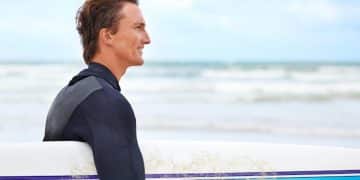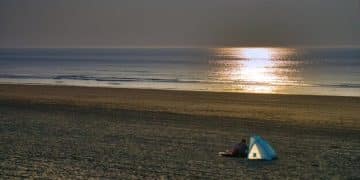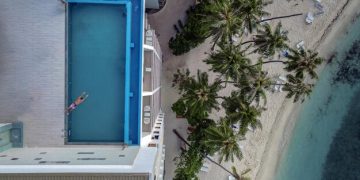Avoid These 5 Common Paddleboarding Mistakes
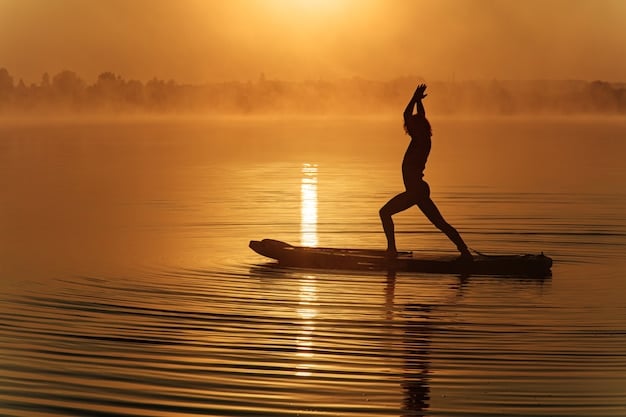
To truly enjoy and excel in paddleboarding, it’s crucial to identify and correct common errors, from improper paddle technique to neglecting safety, ensuring more efficient and enjoyable time on the water.
Paddleboarding offers a unique blend of tranquility and physical activity, making it a favorite for many seeking to connect with the water. However, novices and even some experienced paddlers often commit errors that can significantly hinder their experience. Learning to Avoid These 5 Common Paddleboarding Mistakes That Cost You Time and Energy on the Water is essential for a more efficient, enjoyable, and safe journey.
Mastering the Paddle: The Foundation of Efficient Paddleboarding
Many paddleboarding sessions begin with enthusiasm but can quickly turn into a tiring struggle if basic paddling mechanics are overlooked. Understanding how to properly use your paddle is not just about moving forward; it’s about optimizing every stroke to conserve energy, maintain balance, and effectively steer your board.
The paddle is an extension of your body, and its effective use dictates much of your performance on the water. Proper technique minimizes wasted effort and maximizes propulsion, allowing for longer, more enjoyable outings. Incorrect form, conversely, can lead to muscle fatigue and frustration, making what should be a relaxing activity feel like an arduous task.
Understanding Paddle Sizing and Grip
Selecting the right paddle length is crucial. A paddle that’s too long or too short will force you into an awkward posture, leading to inefficiency and potential strain. Generally, when standing, the paddle should extend about 6-8 inches above your head. As for grip, many newcomers mistakenly hold the paddle with their hands too close together, limiting their reach and power.
- Correct Paddle Length: Stand the paddle upright next to you; the handle should reach your wrist when your arm is extended overhead.
- Proper Hand Placement: Your top hand should grip the handle, and your bottom hand should be about two-thirds down the shaft. This creates a leverage point for powerful strokes.
- Blade Angle: Ensure the blade is angled away from you (the “power face” facing forward) for maximum propulsion through the water.
Implementing the Core Stroke
Effective paddleboarding isn’t just about arm strength; it’s a full-body workout that engages your core and back muscles. The power of your stroke should originate from rotating your torso, rather than just pulling with your arms. This technique is often referred to as the “paddle dance,” where your body moves rhythmically with each stroke.
A common mistake is treating the paddle like an oar, pulling it horizontally along the side of the board. Instead, the paddle should enter the water far forward, ideally as close to the nose of the board as possible, and be pulled straight back, parallel to the board, before exiting the water around your feet. This maximizes the distance the blade travels through the water effectively.
Furthermore, many paddlers neglect the importance of a clean entry and exit of the blade. Splashing and an ungainly exit not only waste energy but also create unnecessary drag. A smooth, controlled movement is indicative of an efficient paddler.
By focusing on correct paddle sizing, proper grip, and engaging the core in each stroke, paddlers can significantly improve their efficiency and reduce fatigue. These foundational elements are often overlooked but are paramount for a rewarding experience on the water, enabling longer distances and more advanced maneuvers with less effort.
Stance and Balance: The Dynamic Duo for Stability and Control
A stable stance is the bedrock of successful paddleboarding. Without it, every wave, wake, or sudden movement can send you tumbling into the water, wasting precious energy and time. Many beginners rush to stand up without first understanding the nuances of how to achieve and maintain balance, inadvertently making the activity much harder than it needs to be.
Your stance is not static; it’s a dynamic interplay between your feet, core, and sense of equilibrium. As conditions on the water change, so too must your stance adapt. Ignoring these foundational principles leads to constant wobbling, inefficient paddling, and an overall less enjoyable experience.
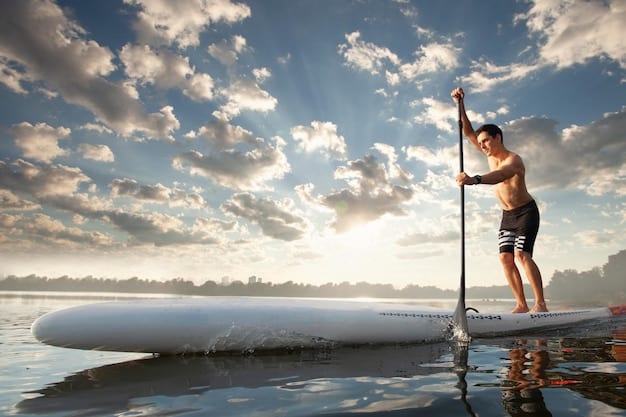
Finding Your Center and Foot Placement
Before even attempting to stand, it’s vital to spend some time kneeling or sitting on the board to get a feel for its stability. Identify the board’s center, which is usually marked or can be estimated by finding the carrying handle. This is your sweet spot for stability.
- Kneeling First: Start on your knees with the paddle across the board, hands gripping the rails for stability. Take a few strokes to get comfortable.
- Transitioning to Standing: Place your feet one at a time exactly where your knees were, hip-width apart, and parallel to each other. Keep a slight bend in your knees.
- Engage Your Core: Your core muscles are crucial for balance. Engage them by imagining someone is about to lightly push you – this natural tension helps stabilize you.
Adapting to Conditions and Maintaining Balance
The water is rarely perfectly still. Learning to anticipate and react to small chop, boat wakes, or even the subtle currents is vital. Your eyes should be fixed on the horizon, not down at your feet, as this helps your inner ear maintain balance.
When encountering a wave or wake, don’t tense up. Instead, absorb the motion by bending and straightening your knees, much like a shock absorber. This allows the board to move beneath you while keeping your upper body relatively stable. Your core should remain engaged, and your paddle can be used as a “third leg” by gently resting it on the water for momentary stabilization.
A common mistake is standing too rigidly. This makes you more susceptible to falling with every small disturbance. Think of your body as a fluid system, constantly making small adjustments to stay upright. Practice makes perfect, and gradually you’ll develop the muscle memory to instinctively correct your balance.
By consciously working on your stance, understanding foot placement, and learning to dynamically respond to water conditions, paddlers can drastically improve their stability and control. This not only prevents falls but also frees up mental energy, allowing you to focus on the beauty of your surroundings and the joy of paddleboarding.
Navigation Neglect: The Hidden Drain on Your Energy
Paddleboarding seems straightforward: get on the board, paddle, and enjoy. However, overlooking basic navigation principles can turn a pleasant outing into an exhausting battle against unseen forces. Many paddlers, especially beginners, underestimate the impact of wind, currents, and even their own paddling technique on their route and energy expenditure. Failing to plan or adapt to these elements is a significant mistake that costs both time and physical energy.
Effective navigation isn’t just about knowing where you’re going; it’s about understanding how to get there most efficiently, considering all external factors. Paddling against a strong headwind or current without a strategic approach can quickly deplete your reserves, turning a short trip into an unforeseen endurance challenge.
Understanding Wind and Current Dynamics
Before every paddleboarding session, make it a habit to check the weather forecast, paying particular attention to wind speed and direction. Wind can be a paddler’s best friend or worst enemy. Paddling with the wind at your back provides an effortless push, while paddling into it feels like hitting an invisible wall.
- Check Forecasts: Always look up wind speed, direction, and tide charts (if applicable) before heading out.
- Paddle Against First: Whenever possible, start your paddle by heading into the wind or against the current. This way, you expend your energy when you’re freshest, and the return trip will be easier.
- Use Land Features: Look for landmarks that might provide a wind break, like shorelines with trees or larger structures, to find calmer water.
Efficient Routing and Stroke Adaptation
Beyond natural elements, your personal navigation choices significantly impact your energy levels. Taking a roundabout way or constantly correcting your direction due to inefficient strokes means more paddling for the same distance. Straight lines and well-executed turns save energy.
Many paddlers struggle to keep a straight course, constantly switching sides with their paddle, which is inefficient. This often stems from not enough forward reach or not paddling parallel to the board. To go straight, focus on a long, powerful stroke that pulls the board forward rather than turning it. When a turn is needed, use sweep strokes (a longer, arcing stroke that acts like a rudder) or pivot turns (shifting weight to the tail of the board).
Moreover, consider the terrain. While open water might seem appealing, paddling along a coastline can offer diverse scenery and sometimes shelter from harsh winds. Being mindful of boat traffic and other water users is also part of smart navigation, ensuring safety and preventing unnecessary evasive maneuvers.
By becoming attuned to wind and current patterns, planning your route strategically, and refining your paddling strokes for directional efficiency, you can drastically reduce the physical demands of paddleboarding. This conscious approach to navigation transforms a potentially exhausting outing into a truly relaxing and rewarding experience, allowing you to cover more distance with less effort.
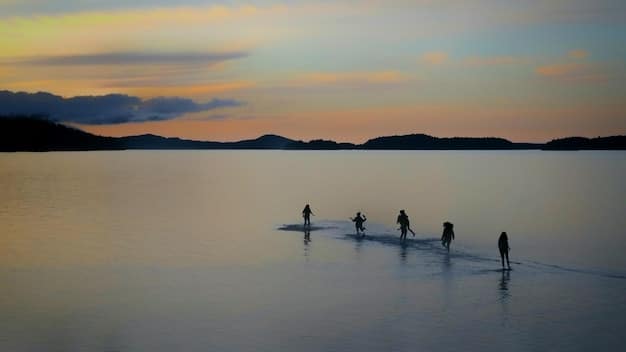
Gear Neglect: Compromising Safety and Performance
Paddleboarding isn’t just about the board and paddle; it’s about a holistic approach to the activity, including the gear you bring and how you maintain it. Many paddlers, particularly those new to the sport, make the mistake of overlooking essential equipment or neglecting the proper care of their gear. This oversight can range from minor inconveniences to significant safety hazards, ultimately costing enjoyment, performance, and sometimes even leading to preventable accidents.
Proper gear selection and maintenance are not optional extras; they are fundamental components of a safe, comfortable, and efficient paddleboarding experience. Failing to address these aspects can lead to discomfort, equipment failure, or even put your life at risk on the water, highlighting the critical importance of being well-prepared.
Essential Safety Gear Overlooked
The most critical piece of safety equipment, often neglected by recreational paddlers, is the Personal Flotation Device (PFD). While some might consider themselves strong swimmers, unforeseen circumstances like being knocked unconscious or becoming separated from your board in strong currents can quickly turn dangerous. A PFD is non-negotiable for safety.
- Always Wear a PFD: Even in calm waters, a PFD can be a lifesaver. Ensure it fits properly and is approved for paddle sports.
- Leash Attachment: Your board is your largest flotation device. A leash keeps you connected to it, preventing it from drifting away in strong winds or currents after a fall.
- Whistle/Communication Device: A simple whistle can alert others to your presence or distress. For longer trips, consider a waterproof phone case or VHF radio.
Maintenance and Proper Equipment Care
Beyond safety items, the general upkeep of your board and paddle is often overlooked. Saltwater, UV exposure, and general wear and tear can degrade equipment over time, shortening its lifespan and affecting performance. A well-maintained board will perform better and last longer, saving you money and frustration in the long run.
After each use, especially in saltwater, rinsing your board and paddle with fresh water is crucial to prevent salt crystal buildup and corrosion of metal parts (if any). Storing your board out of direct sunlight prevents UV damage and warping. Periodically check your fin box for sand or debris, and ensure your leash is free of nicks or fraying.
For inflatable SUPs, proper inflation pressure is vital for performance. Under-inflated boards are unstable and difficult to paddle, whereas over-inflation can cause damage. Always follow the manufacturer’s recommendations. Regular checks of your pump and valves are also part of good maintenance practices, ensuring you can always inflate your board properly.
By prioritizing the selection of appropriate safety gear and committing to a routine of proper equipment care and maintenance, paddlers can significantly enhance their safety, extend the life of their gear, and enjoy a more consistent, high-performance experience on the water. Ignoring these details is a mistake that ultimately costs peace of mind and potentially much more.
Ignoring the Conditions: A Recipe for Discomfort and Danger
Many paddleboarders make the critical error of heading out onto the water without adequately assessing the prevailing conditions. This often stems from a combination of eagerness, overconfidence, or simply a lack of awareness about how dynamic water environments can be. Launching into strong winds, unexpected currents, or deteriorating weather without proper preparation is a mistake that can quickly turn an enjoyable activity into a frustrating, dangerous, and energy-draining ordeal.
Understanding and respecting the elements are paramount for any water-based activity. The conditions can change rapidly, and what might seem calm from the shore can be significantly different further out. Ignoring these variables is not just inefficient; it’s a direct threat to your safety and enjoyment, potentially costing you precious time and physical exertion.
Assessing Weather and Water Dynamics
Before even stepping foot on your board, make it a habit to perform a thorough check of the weather forecast, paying attention to more than just sunny skies. Wind reports, potential for storms, and changes in water temperature are all vital pieces of information. For coastal paddleboarding, understanding tide charts and current predictions is equally important, as strong currents can make returning to shore a grueling task.
- Monitor Wind: Be especially wary of offshore winds, which can carry you far from shore unexpectedly. Headwinds make paddling significantly harder.
- Check Forecasts Regularly: Weather can change quickly. A forecast checked in the morning might not be accurate for an afternoon paddle.
- Observe Water State: Look at the water’s surface from different angles. Are there whitecaps? Is the water moving faster than usual? These are visual cues that can indicate challenging conditions.
Choosing the Right Location and Time
Beyond the meteorological forecast, selecting an appropriate location and time for your paddle can mitigate many risks. Beginners should stick to calm, sheltered waters like lakes, canals, or protected coves. Venturing into open ocean or high-traffic areas prematurely can be overwhelming and dangerous.
The time of day also plays a crucial role. Early mornings often offer the calmest waters and lighter winds, making for a serene paddling experience. Midday can bring stronger breezes and more boat traffic, while late afternoon storms are a common occurrence in many regions. Planning your paddle around these patterns helps optimize your enjoyment and minimize effort.
Moreover, it’s essential to understand your personal limits. Paddling in conditions that are beyond your current skill level won’t build character; it’s more likely to build frustration and put you in a dangerous situation. Gradually challenge yourself as your confidence and ability grow, always erring on the side of caution. If in doubt, it’s always better to stay ashore and paddle another day.
By proactively assessing environmental conditions, from wind and current to weather patterns, and by making informed decisions about where and when to paddle, you can significantly enhance your paddleboarding experience. Avoiding the mistake of ignoring these crucial factors ensures a safer, more enjoyable, and less exhausting time on the water, allowing you to truly immerse yourself in the beauty of the activity.
| Key Mistake | Brief Description |
|---|---|
| 🚫 Improper Paddle Use | Incorrect paddle sizing, grip, and stroke technique lead to wasted energy and reduced propulsion. |
| 🌊 Unstable Stance | Poor foot placement and rigid body posture compromise balance, causing falls and inefficiency. |
| 🗺️ Navigation Neglect | Ignoring wind/currents and inefficient routing exhausts paddlers and prolongs trips. |
| 🛠️ Gear Oversight | Forgetting safety gear or neglecting equipment maintenance impacts performance and safety. |
Frequently Asked Questions About Paddleboarding Mistakes
One of the most frequent errors for beginners is improper paddle technique. Many new paddlers rely too much on arm strength, failing to engage their core músculos. This leads to quick fatigue and inefficient propulsion, making the experience much harder and less enjoyable than it needs to be, diminishing the fun of exploring the water.
To enhance balance, start by kneeling on the board to find its center of stability before standing. Once upright, keep your feet parallel and hip-width apart with slightly bent knees. Focus your gaze on the horizon, not your feet, and engage your core. Practice in calm waters to develop muscle memory and confidence.
Ignoring weather conditions, especially wind and currents, is a critical mistake. Unexpected strong winds can push you offshore, while currents can make returning exhausting. Checking forecasts and observing water conditions ensures your safety, helps plan an efficient route, and conserves energy for an enjoyable outing.
The most crucial safety gear includes a properly fitted Personal Flotation Device (PFD), a leash to keep you connected to your board, and a whistle for emergencies. For longer trips, consider a waterproof phone case or a VHF radio. These items are vital for preventing accidents and ensuring help can be summoned if needed.
Neglecting maintenance, such as not rinsing saltwater or storing boards in direct sunlight, can degrade equipment over time. This leads to reduced lifespan and compromised performance, making your board unstable or less efficient. Proper care, like appropriate inflation for inflatables, ensures your gear remains in top condition for optimal use.
Final Strokes: Maximizing Your Paddleboarding Adventure
Ultimately, a successful paddleboarding experience is not measured by how many times you fall, but by how much you learn and adapt. The water is a dynamic environment, and becoming a proficient paddler involves a continuous process of understanding your equipment, your body, and the elements around you. By consciously working to avoid these 5 common paddleboarding mistakes that cost you time and energy on the water, you’re not just preventing frustration; you’re actively enhancing your ability to connect with nature, enjoy a superb workout, and create lasting memories. Embrace these lessons, and your time on the board will transform from a challenging new hobby into a truly effortless and exhilarating adventure, leaving you with more energy to explore and savor every moment.

